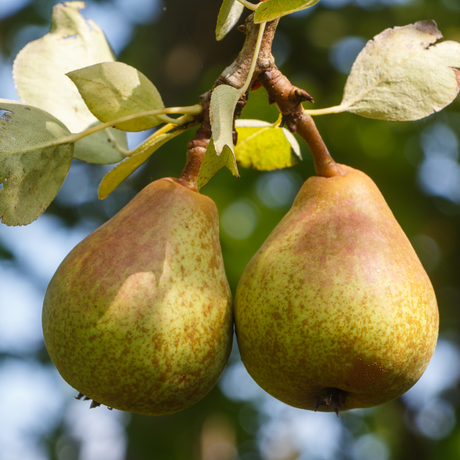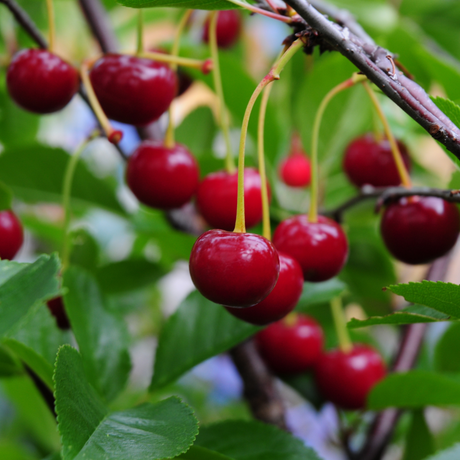- Our favoriteSold out
Peach tree low trunk - 80cm high - 5 liter pot
€34,66Unit price /Unavailable Peach tree low trunk - 80cm high - 5 liter pot
€27,72Unit price /Unavailable
Peach trees in pictures
In this video, Tom shows the collection of fruit trees for his new garden.

Also read our fruit tree cultivation guide
Our other fruit trees
View allBuy a peach tree – your summer treat
Buying a peach tree is more than just a fruit choice: it's an investment in fragrance, color, and juicy summers in your own garden. The peach tree (Prunus persica) is a fruit tree known for its beautiful pink flowers in spring and the delicious fruit that can be harvested in summer. This tree is known for its beautiful flowers and fruit, making it a valuable addition to any garden. At Plukkers, we select varieties that thrive in our climate—even without being a pro. The peach tree is an excellent choice for those looking for a graceful and productive fruit tree.
There are several varieties of peach trees available, each with its own unique characteristics such as ripening time, fruit color, and disease resistance. Standard peach trees stay smaller than half-standard trees. Discover the types of peach trees that suit your needs and garden conditions.
Why choose a low-stemmed peach tree (Prunus persica)?
- Fresh fruit experience: Pick juicy peaches straight from the branch; picking is especially easy with a half-standard or standard peach tree because the first branches start at shoulder height.
- Compact growth: ideal for smaller gardens, pots, or urban spaces; peach trees are also suitable for growing as shrubs.
- Ornamental value: beautiful blossom in spring as an eye-catcher
- Fast harvest: many varieties bear in the 1st or 2nd year
- Self-pollinating convenience: no additional tree required for fruiting
- Peach trees are a versatile fruit tree and are available as dwarf, half-standard, and standard peach trees. A half-standard peach tree combines compact growth with ease of harvesting, as the primary branches are lower, making the tree easily accessible for maintenance and harvesting. Standard peach trees are more suitable for larger gardens and often yield a larger harvest.
Various types of peach trees in our collection
The peach tree belongs to the botanical family Prunus, with the specific species name Prunus persica. This family also includes other fruit trees such as plums and cherries. Prunus persica is the scientific name for the peach tree, which grows well in the Netherlands. There are several varieties of peach trees available, each with unique characteristics such as ripening period, fruit color, flavor, and disease resistance. By choosing from the various types of peach trees, you can select a variety that best suits your garden and needs.
Planting a peach tree: location and care
- Sun & Shelter: Give your peach tree a warm, sheltered spot in full sun. A sunny location is essential for optimal flowering and a bountiful harvest. Peaches bloom in spring with beautiful flowers, which is important for fruit set. Like other fruit trees such as plums, cherries, and pears, peach trees benefit from plenty of sunlight to flower well. Peach trees need a sunny, sheltered spot to thrive.
- Soil: Plant your peach tree preferably in the open ground for healthy growth and abundant fruit. Use a tree stake or stakes for support when planting, especially for young trees. The rootstock determines the tree's ultimate size and is important for growth and fertility. Choose airy, well-drained soil enriched with compost. A healthy plant from a nursery increases the chance of a successful planting of your fruit tree. Planting in a pot is possible, but fruit trees often develop better in the open ground.
- Pruning: After harvest, prune to retain light in the crown. Always remove crossing branches and keep the tree well pruned to keep the crown open and healthy. This promotes air circulation and helps prevent disease. Also pay attention to the trunk when pruning and avoid damage.
- Watering requirements: Provide ample water regularly, especially during dry periods and after flowering. Sufficient water is essential for fruit trees and supports growth and fruit development.
- Fertilization: Apply organic fertilizer in early spring. Fertilization is important for stone fruits such as peaches, plums, and cherries to promote a good harvest and healthy growth. Ensure disease prevention through proper care and location.
Planting a peach tree: here's how
Want to plant a peach tree? I'd be happy to give you the best advice for a good start! Plant your tree slowly in the fall or early winter; between September and January works perfectly. This gives your young tree all the time to settle in and establish strong roots before the growing season begins. Find a spot with plenty of sunshine—peach trees are true sun worshippers and love warmth and light. Pay close attention to the soil: it must be well-draining, as wet feet are a definite no-go for your tree's roots. A slightly chalky soil will make your peach tree especially happy, giving it the boost it needs for beautiful growth and delicious, sweet fruits.
Dig a spacious planting hole, ensuring the graft point of your tree is a hand's width above the ground—don't bother, just dig in the soil with your hands. Fill the hole with humus-rich garden soil and gently press the roots down, as if you were soaking a baby. Water generously after planting (your tree is thirsty!) and cover the root ball with a layer of humus, straw, or black plastic sheeting to prevent dehydration. Planting multiple trees? Then maintain a distance of 4 to 5 meters—everyone needs their own space, even trees. And don't forget to lightly prune your peach tree after planting to keep the roots and branches in balance. This way, you'll give your peach tree the best start for healthy growth, and soon you'll be able to enjoy those deliciously juicy, sweet fruits from your own garden!
Preventing and treating diseases in peach trees
Your peach tree can sometimes get diseases like leaf curl and gum disease—not fun, but fortunately, easily preventable! These annoying pests can really mess with your leaves, branches, and fruit. The best thing you can do? Regularly check your tree and see if anything unusual is happening. See any diseased or damaged areas? Just prune them away immediately, otherwise, it will spread like wildfire throughout your entire tree. And don't forget to prune openly—your tree loves fresh air and light just as much as you do, and fungi find that very unpleasant.
Keep things nice and clean around your tree. Those fallen leaves and fruit may seem harmless, but they can actually transmit diseases to your tree. We prefer using natural remedies against pests and fungi—they work well and your tree stays healthy. Pay close attention to the early signs and take action quickly if you see anything. That way you can enjoy those delicious, juicy peaches you so eagerly await year after year!
Harvest and use
Peaches ripen between June and August, depending on the variety. It's best to pick peaches while they're still on the tree to prevent damage and rot. Pick them as soon as they feel soft and have a wonderful aroma. The peach skin is characterized by its fuzzy coat, which distinguishes it from nectarines, for example. Enjoy delicious peaches from your own garden: use the sweet fruits immediately, in compote, pie, jam, or store them in the freezer.
Peach tree and health: a tasty boost
Your peach tree is a real treat: not only beautiful to look at, but also packed with delicious, juicy fruits that will give your health a significant boost. These sweet treasures are packed with vitamin C, potassium, and antioxidants—exactly what your immune system and skin crave. And the best part: they're also low in calories and fat, so they fit perfectly into your daily diet without any guilt.
The great thing about growing and caring for your own peach trees is that you not only get fresh peaches, but also a relaxing experience. There's something incredibly calming about working with trees and watching your own fruit grow—a true natural stress reliever. This way, you kill two birds with one stone: enjoying healthy, sweet peaches and fostering an active, relaxed lifestyle. Enjoy your peach trees!
Perfect for garden and balcony
Because many peach trees are available as standard trees, shrubs, or even suitable for growing in pots, they thrive in smaller gardens, compact spaces, and even on balconies. Even if you live in the city, you'll soon be able to enjoy your own brick-red peaches. Add color, fragrance, and flavor to your outdoor space with a peach tree from Plukkers.












